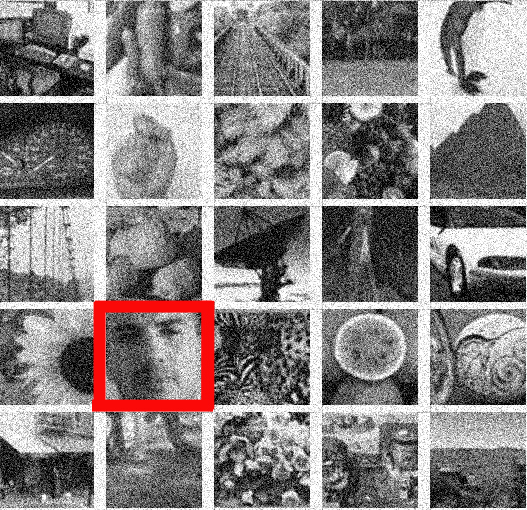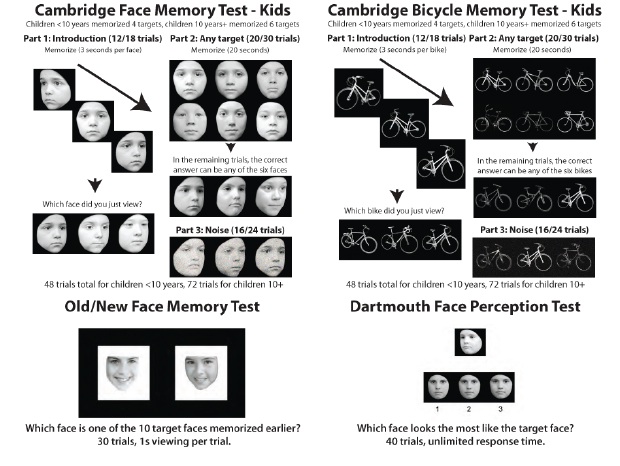FACES AMONG NON-FACES

FACES AMONG FACE PARTS



FACE DETECTION
Impaired face detection may explain some but not all cases of developmental prosopagnosia
Kirsten A. Dalrymple & Brad Duchaine
A popular theory of the normal development of face processing (Morton & Johnson, 1991) suggests that two processes are involved in becoming proficient with face recognition: 1) a natural attraction to faces that is stronger than the attraction to non-face objects, and 2) a learning mechanism that uses the input from the first system to tune face processing. This theory leads to a prediction that developmental prosopagnosia (DP) could result from a failure of the face attraction system and that this failure could then prevent an individual from then learning to recognize faces (Johnson, 2005). As a measure of natural attraction to faces, we tested the face detection abilities of seven children with DP with two tasks to see if they could find faces as quickly and as accurately as children with normal face recognition. One task required participants to find faces among non-faces (objects, scenes, etc.), and the other required participants to find faces among scrambled face parts. Four of the seven DP children were impaired at finding faces to some degree while the remaining three children performed normally on the tasks. The cases with impaired face finding are consistent with the idea that DP could result from a failure of face detection. However the cases with normal face finding implicate another cause. This supports the growing body of literature that suggests that DP is a heterogeneous disorder with multiple types and causes. This work was recently published in the journal Developmental Science. Click here to read the full report.


DISSOCIATION BETWEEN FACE PERCEPTION AND MEMORY
Dissociation between face perception and face memory in adults, but not children, with developmental prosopagnosia
Kirsten A. Dalrymple, Lúcia Garrido, & Brad Duchaine
Cognitive models suppose that face recognition is accomplished through a series of discrete stages, including perceptual representation of facial structure, and encoding and retrieval of facial information. This implies that impaired face recognition can result from failures of face perception, face memory, or both. Studies of acquired prosopagnosia, autism spectrum disorders, and the development of normal face recognition support the idea that face perception and face memory are distinct processes, yet this distinction has received little attention in developmental prosopagnosia (DP). To address this issue, we tested the face perception and face memory of children and adults with DP. By definition, face memory is impaired in DP, so memory deficits were present in all participants. However, we found that all children, but only half of the adults had impaired face perception. Thus, results from adults indicate that face perception and face memory are dissociable, while the results from children provide no evidence for this division. Importantly, our findings raise the possibility that DP is qualitatively different in childhood versus adulthood. This work is an important first step, but longitudinal studies are necessary to better understand the developmental trajectory of face perception and face memory deficits in DP. This work was recently published in the Journal of Developmental Cognitive Neuroscience. Click here to read the full report.
NORMAL DEVELOPMENT: INFANT STUDIES
Infants as young as 9-minutes-old track faces to a greater degree than comparable non-face stimuli (Johnson, et al., 1991). We are in the process of investigating the role of the right hemisphere in the normal development of face processing by monitoring the eye movements of infants while they watch a face and a scrambled face moving on a computer screen. We hope that these results will provide important information about early hemispheric specialization, and development of the face processing system. This work, headed by Dr. Kirsten Dalrymple, is currently underway in the E-lab at the Institute of Child Development at the University of Minnesota.


ORIENTING TO FACES
In collaboration with Richard Cook at City University London, we are investigating whether children with developmental prosopagnosia orient their attention to faces in a normal way. In typically developing adults and children, attention is drawn to faces and face-like stimuli, even if they contain only very primative face-like features (see figure). We are investigating whether children with face recognition difficulties show this normal orienting of attention to faces. A failure to orient to faces may explain why face recognition failed to develop in these individuals. This work, headed by Dr. Kirsten Dalrymple, is currently underway in the E-lab at the Institute of Child Development at the University of Minnesota.
Click here to learn about the current prosopagnosia research at Bournemouth University in the UK.
As of 2019, this page is no longer being updated.
Dr. Kirsten A. Dalrymple, PhD
Institute of Child Development
University of Minnesota
Copyright © 2014